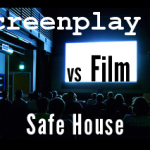Janet Evanovich’s Stephanie Plum novels certainly rake in the the dough. The last one in the series, Explosive Eighteen, sold 744,000 hardcovers in 2011 (figure courtesy of Publishers Weekly).
When it comes to books, Stephanie Plum has the Midas touch. But just because a novel comes from a blockbuster series doesn’t mean that its movie adaptation will be a blockbuster too.
Such was the case with One for the Money, an adaptation of the first novel in the Plum series, in which Stephanie’s first case as a new bounty hunter is to track down her old flame, Joe Morelli. Despite the enormous popularity of the series, the movie only made $26 million dollars in the US (and $10 million abroad).
Because of its large fan base–accumulated over 18 novels no less!–the movie’s lackluster ticket sales must have come as a shock to the studio. To me too. So I thought I’d watch it, and try to find out what happened.
Before I share my conclusions, I just want to say something regarding the leading lady, Katherine Heigl. There are a lot of Heigl-haters out there. I know she’s made some alienating comments in interviews, but I’ve always thought she was a great romantic comedy actress. I don’t really understand all the antipathy.
But for those of you who want to argue, “Of course One for the Money tanked. Heigl was in it!” I think you’re wrong. From the Amazon reviews I skimmed, most Plum fans felt Heigl nailed Plum’s character. The problem wasn’t Heigl. The problem was the script. Here’s my take:
Beginning with exposition is like serving an appetizer of Brussels sprouts
The beginning of One for the Money is one super-sized platter of exposition. We get introductions to Stephanie, to the Burg, to her parents, to her grandmother…then another round of intros to the staff at her cousin Vinny’s bail bonds operation.
If you’re a fan of the Stephanie Plum series the movie is based on, then these introductions would probably be fun for you. But what about the rest of the movie-goers who chose to watch One for the Money because they were in the mood for a good action-comedy? They weren’t looking for a whole bunch of backstory on Steph and Grandma Mazur.
Your screenplay should begin with a hint of whatever genre it is. If you’re writing a comedy, then begin with a humorous scene. If you’re writing an action movie, then by all means, kick it off with a bit of action. It doesn’t have to be intense–save that for later, for the midpoint and for the climax. Just a taste of what’s to come, a promise that there will be more.
If your audience’s first taste of your movie is a large serving of exposition, it’s like inviting them to a fancy dinner and serving them Brussels sprouts for their appetizer.
Make the beginning of your movie more appetizing than a bitter vegetable.
Study the opening of Sherlock Holmes; there’s a hint of action-adventure, a small sampling of the exploits we’ll witness later. If you’re looking for a good way to start a comedy, Bridesmaids is a fine example. Beginning a movie with a mystery always works, regardless of its genre, because a mystery hooks the audience’s interest right away. One of the best examples of this approach is The Hangover.
I’m not saying that the beginning scenes of One for the Money weren’t funny, but they weren’t funny enough for the portion of the audience that had never picked up a Stephanie Plum novel. I think the movie would’ve been much better if it had started with Stephanie in the middle of bungling a bounty hunting attempt, and Ranger, (a more experienced bounty hunter with lots of muscles for those of you not familiar with the books), comes to her rescue.
Actually, there’s a scene much later in the movie which would’ve worked perfectly as an opener. Stephanie’s trying to apprehend a suspect, but she’s so inept, the suspect shoots Ranger with the gun Ranger bought Stephanie. With this opening, we would’ve gotten our introduction to Stephanie (and to Ranger), but it’s packaged in a nice combo of action and comedy.
(If you think writing exposition is one of your screenplay weaknesses, reading Exposition in Film: Definition & Examples from The Tourist might be helpful.)
Ticket prices raise expectations
If someone’s paying upwards of $10 for a movie ticket, then they expect to experience $10 worth of entertainment. I don’t think One for the Money delivered the goods. It isn’t what you’d call a high-octane thriller.
There’s one tame explosion, a mild bout of fisticuffs (or two), and not a single high-speed car chase. (That’s not to say an overload of car chases or explosions can improve a bad script.)
Additionally, One for the Money’s pacing was very languid. It felt more on par with the pacing of a TV procedural than of a commercial film. (Not to mention Plum’s sparring with Morelli felt reminiscent of Brennan’s sparring with Booth on Fox’s hit crime show, Bones.) As a movie-of-the-week, I think One for the Money would fare well. But as widespread film release, it doesn’t meet audience expectations.
Cause of death: overdose of phone calls
In a lot of screenplay vs film posts, I’ve mentioned that produced movies usually reduce the number of phone conversations which were written in the original script.
Not One for the Money. The first half of the movie abounds with phone calls: Stephanie calls her friend Mary Lou when Stephanie’s scoping out Morelli’s apartment. She calls Mary Lou again when Ranger buys her a gun. She calls her family while she’s baiting a trap for Morelli. Then she’s again on the phone with Mary Lou after Ranger gets shot by the gun he bought Stephanie.
These phone calls were unnecessary (unless, you know, Motorola or Apple was paying for product placement). The calls just brought the plot to a screeching halt–and really, what was the point of Mary Lou? She didn’t have a single scene where she wasn’t on the phone with Stephanie!
It’s true though that the lighthearted phone calls, juxtaposed against the roughness of the bounty hunting world, could provide much-needed interjections of comic relief. But they didn’t work, maybe because Stephanie’s bounty hunting world wasn’t violent enough.
In other words, Stephanie’s conversations with the characters who inhabit her Burg would have been funny if they contrasted with some R-rated danger. Something along the lines of that in scene in RED, where Helen Mirren’s character composes floral arrangements…while a semi-automatic weapon rests in her lap. Now that contrast created humor.
Of course, not all phone conversations have to be eliminated. Sometimes there’s no other way for events to logically take place. (How else would Stephanie been decuffed from her shower curtain if she hadn’t called Ranger?) And sometimes a phone call is the only way to exact Queen Bee style retribution.
Toss in a ticking clock
If Stephanie failed in her mission to bring in Morelli and secure the $50,000, what did she lose? Where were the stakes?
Sure, her car had been towed, and she had to drive her grandmother’s eyesore of a Cadillac (but in its defense, its engine is solid). She was also getting threatening notices from her landlord, so she might have had to move in with her parents.
These may very well be horrifying things for Stephanie, but if they were, I never felt it. There never seemed to be anything at stake for Stephanie, not until the end at least. Because there was nothing at stake, it was hard to care about whether or not Stephanie succeeded in finding Morelli.
There was nothing urgent about her mission either. It seemed to me that Stephanie could’ve brought in Morelli in three weeks or three months or…three years. The lack of urgency is also one reason why the movie felt so slow. If there had been a deadline in the movie, and if Stephanie faced dire consequences if she didn’t make it, the movie would have had both stakes and urgency…and maybe a bigger box office take.
For a good explanation of how goals, stakes and urgency all work together to improve your script, read this article by Carson Reeves or my book, Story Stakes.
Confucius says, “don’t be confusing!”
When Stephanie learns that Jimmy Alpha, proprietor of a sketchy gym, might have info on Morelli, she pays a visit to Alpha’s dirty boxing club. Alpha tells her, “first you want information on Morelli. Then you’re looking for Benito Ramirez. Now you want to know about Carmen. If you’re trying to confuse me, you’re doing a great job. Pick one.”
Jimmy wasn’t the only confused one–so was I. I had a handle on Morelli alright, but the others…it took me awhile to figure out the relationship between Jimmy, Benito, and Carmen, and in turn, what their importance was to Stephanie. It was too much information to digest all at once. If I had been reading the book, I could have flipped back and re-read some pages. I was watching the movie at home, so I paused and rewound, which was annoying. But if I had seen the movie in the theaters, I wouldn’t have been able to do anything, except stare at the screen in confusion.
Each character who plays a key role in the plot should have a clear and distinct introduction. That way the audience can keep track of who is who and what each wants. If you confuse your audience, you’re opening the door for them to disengage from your story.
Don’t sacrifice your character for laughs
Honestly, at the beginning of One for the Money, I didn’t feel that Stephanie was a badass. I thought she was lame. She gets herself into a closed ring with a boxing thug and tries to fight him off with her handbag. Really? That didn’t read sassy to me. It read stupid.
I know she’s a beginner, but how can she expect to apprehend real criminals when she can’t accurately hit a practice target? That’s bad enough, but when her incompetence got Ranger shot with the gun Ranger bought her, I got really annoyed.
These scenes were played for laughs, and that’s all well and good. But there’s a fine line between funny and pathetic (see screenwriting tip #11 from this article on Bridesmaids). Jokes which humiliate your main character may make your audience laugh…but if they also shred any empathy for your hero, then the comedy set piece isn’t worth the punch line.
Stephanie’s carelessness also leads to the death of an innocent witness and to the brutal beating of one of her friends. Maybe at these moments, I was supposed to feel sorry for Stephanie. But I didn’t; I felt disgusted that her incompetence was getting people hurt.
After these incidents, Stephanie rallies. She yells at one of her relatives who’s a cop, “They talk, they die. Do something!” And her fiery attitude ends up saving lives.
Yes, Plum redeemed herself. But at 77 minutes into the movie, it felt like too little too late.
Final thoughts
One for the Money wasn’t all bad. The scenes between Plum and Morelli zinged with chemistry, and are good to study if you’re writing a romantic comedy. The shower-cuff scene is a classic. And the end of the movie has one of the best lines ever: “I’ve got two dead bodies, a hitman, an FTA, and a bullet in my a**. Requesting aid with transfer.”
Awesome.
But the chemistry between Plum and Morelli wasn’t enough to save the movie. And while it got better, not everyone in the audience would have had the patience to watch it through til the end–except for stalwart fans of the novels.
If you’re writing a screenplay adaptation of a novel, there’s a huge takeaway lesson here: make sure your script can capture and maintain the interest of someone who has never read the book.
…so was I too harsh on One for the Money? Or was it better than I concluded?
Mystery by Savara





















Comments on this entry are closed.
I’ve read ALL the Evanovich Plum novels and thus feel I can say with sureness that your review was dead on.